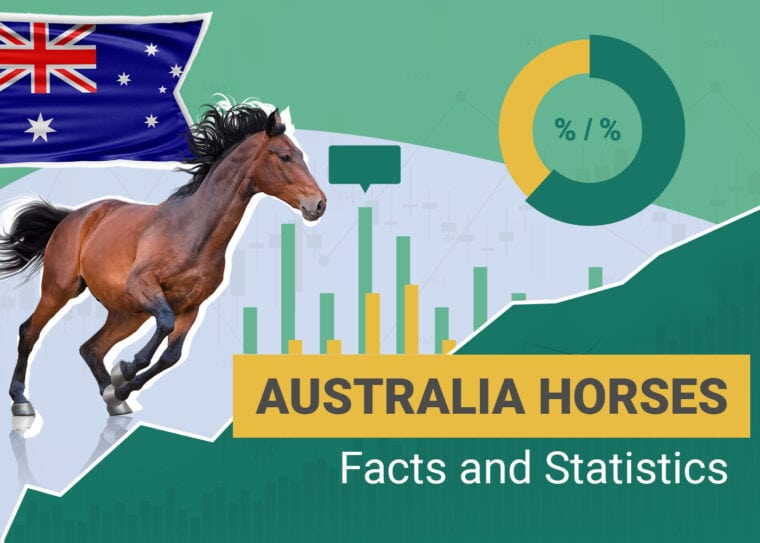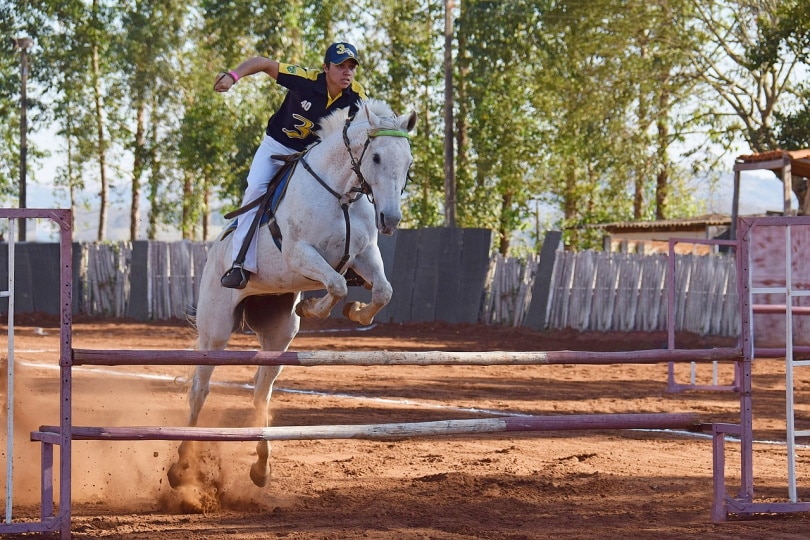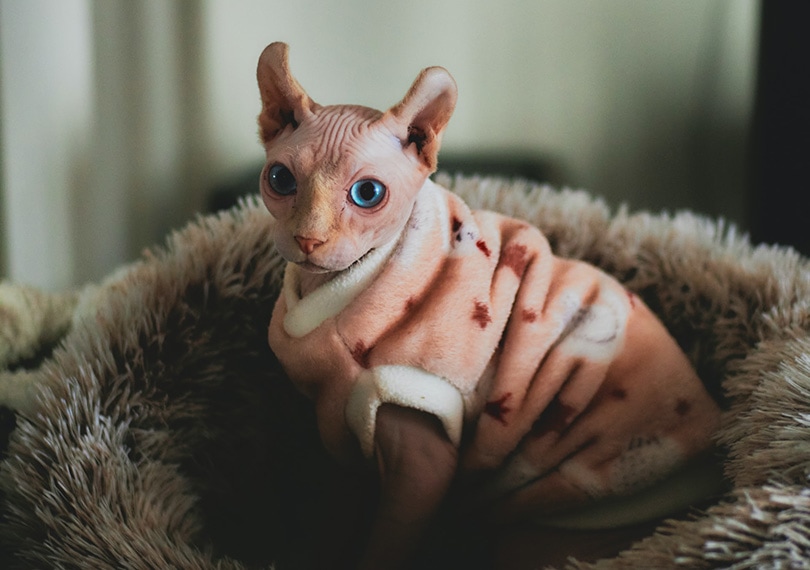
Click to Skip Ahead
Note: This article’s statistics come from third-party sources and do not represent the opinions of this website.
Horses are a big business in Australia, especially in horse racing. The popular sport contributes vast amounts of money to the country’s economy. Australia is home to several horse farms and breeding operations that export horses worldwide. Feral horses are also abundant and have caused significant controversy among groups concerned with environmental protection.
If you’ve ever wondered about the Australian horse industry, you’ve come to the right place! Here are 10 Australian horse statistics that will give you an overview of these animals in this country.
Top 10 Australia Horse Statistics
- Nearly 37% of bets on racing events are placed online.
- The thoroughbred breeding industry contributes over $1.16 billion annually to the Australian economy.
- The horse racing industry in Australia employs nearly 75,000 people.
- 3,409 horse farming businesses in Australia employ 3,866 people.
- Australia has the second-largest thoroughbred breeding industry in the world, with over 660 stud farms across the country.
- Approximately 79% of Australian breeders live away from capital cities.
- 47% of horse breeding workers are female, and the median age is 51.
- Australia has the world’s largest population of feral horses, numbering approximately 400,000.
- The National Parks and Wildlife Service plans to reduce the wild horse population in Kosciuszko National Park to 3,000 horses by 2027.
- Equestrian Australia had 22,779 members in 2023.

Australian Horse Racing Statistics
1. Nearly 37% of bets on racing events are placed online.
(Gamble Aware)
Although most types of gambling are declining in Australia, online gambling is more popular than ever. Placing a bet from the comfort of your home is much easier than heading to the racetrack, and 70% of sports betting occurs online.
2. The thoroughbred breeding industry contributes over $1.16 billion annually to the Australian economy.
(AgriFutures)
Approximately 65% of this economic impact occurs in the province of New South Wales, where nearly 18,000 individuals participate as competitors, volunteers, or employees. Most breeding farms in Australia are dedicated to thoroughbreds, which are frequently shipped domestically and overseas for racing.
3. Australia’s horse racing industry employs nearly 75,000 people.
(Thoroughbred Industry)
There are more racecourses in Australia than in any other country, and it has 371 racing clubs. Nearly 80% of the Thoroughbred racing jobs are in Queensland, New South Wales, and Victoria.
Horse Farming Industry Statistics

4. There are 3,409 horse farming businesses in Australia that employ 3,866 people.
(IBISWorld)
Operators of horse farms perform various activities, including sales and servicing, which account for the largest proportion of industry revenue. The most common breeds are Thoroughbred, Standardbred, and Arabian.
Thoroughbreds and Standardbreds are primarily sold to trainers for track and harness racing, while other breeds are sold to the public for recreational purposes.
5. Australia has the second-largest thoroughbred breeding industry in the world, with over 660 stud farms across the country.
(AgriFutures)
Most stud farms are located in New South Wales, Victoria, and Queensland and supply both domestic and overseas markets. Approximately 76% of breeding operations have only one or two mares. Breeders with five or fewer horses own more than half of the mares owned by breeding operations.
6. Approximately 79% of Australian breeders live away from capital cities.
(Labour Market Insights)
It’s not surprising that most breeders live in rural areas, but some regions have much higher concentrations of breeders. Victoria and New South Wales have more horse breeders, and the largest number of workers are in Hume, Hunter Valley, and Darling Downs.
7. 47% of horse breeding workers are female, and the median age is 51.
(Labour Market Insights)
Most horse breeders in Australia are 45 to 54 years old, and the number of employees over 65 is much larger than in other professions. Younger Australians (19 to 24-year-olds) make up the smallest group, but they’ve embraced online gambling on races more than other age groups.
Feral Horse Statistics

8. Australia has the world’s largest population of feral horses, numbering approximately 400,000.
(Invasive Species Council)
The high numbers of feral horses cause significant ecological damage to fragile ecosystems in the Australian Alps, which includes Alpine and Kosciuszko National Parks. Feral horse populations are established in at least 10 conservation areas in Australia.
9. The National Parks and Wildlife Service plans to reduce the wild horse population in Kosciuszko National Park to 3,000 horses by 2027.
(NSW Government)
Scientists welcome the idea of removing the feral horses but are concerned that it won’t be enough to stop overpopulation. The Australian Academy of Science argues that the population needs to be reduced to under 3,000 individuals to stop the damage to local flora and fauna.
Australia’s alpine environment, where the feral horse population primarily lives, covers only 1% of the continent but is home to many threatened and endemic species that aren’t found anywhere else in the world.
Equestrian Sports Statistics

10. Equestrian Australia had 22,779 members in 2023.
(Equestrian Australia)
Equestrian Australia sanctions dressage, eventing, jumping, showing, vaulting, driving, and endurance competitions. It is also responsible for licensing over 814 coaches and 1,129 officials. The Australian Equestrian Team has won 23 Olympic and Paralympic medals since 1956.
Frequently Asked Questions About the Australian Horse Industry
How many horses are there in Australia?
Australia has approximately 1 million domestic horses, but some estimate the number to be closer to 500,000, while others insist it’s over 1.4 million. Determining a precise number is difficult since some births are not reported. (National Horse Traceability Project)
How many horses have died in horse racing this year?
The Coalition for the Protection of Racehorses reported 168 horse deaths on Australian racetracks between August 1, 2022, and July 31, 2023. Foreleg injuries were the leading cause of death, followed by hind leg injuries.
While the 2021 Melbourne Cup reported zero horse injuries, it is only the third year that this has occurred since 2013. As Australia’s most popular horse race, it is also purportedly the deadliest, with seven horses dying during or immediately after the race in the last 9 years. In 2023, the Melbourne Cup was canceled due to public concerns over the horses’ welfare (PETA)
How profitable is the horse industry in Australia?
In 2023, the horse farming industry in Australia made $1.6 billion in revenues. Between 2018 and 2023, the industry grew by 0.5%. However, other related industries also inject money into the economy. For instance, the sports betting industry, which includes horse racing, made 6.4 billion in revenue in 2024. (IBIS World: 2 sources)
Conclusion
The Australian horse industry is one of the world’s largest, and horse racing plays a prominent role in its success. Tracks around the country contribute a significant amount of money to the Australian economy. However, the sport isn’t without its faults, and many Australians oppose horse racing because of the large number of injuries and deaths.
Breeding operations export large numbers of horses overseas, but the aging population of horse farm owners may lead to a future decline in the industry. Australia is also home to a large population of feral horses, which is causing concerns about the deterioration of sensitive ecosystems. The Australian Government is involved in mitigating wild horse growth, but it’s a complex task.
Related Reads:
- Australia Service Dog and Pet Therapy Statistics to Know
- Largest Pet Food Manufacturers in Australia
- Australian Pet Food Industry Statistics to Know: Trends, Market Size & Analysis
- How Many Horses Are There in Australia? Statistics & Facts
Featured Image Credit: Horsemen, Shutterstock







